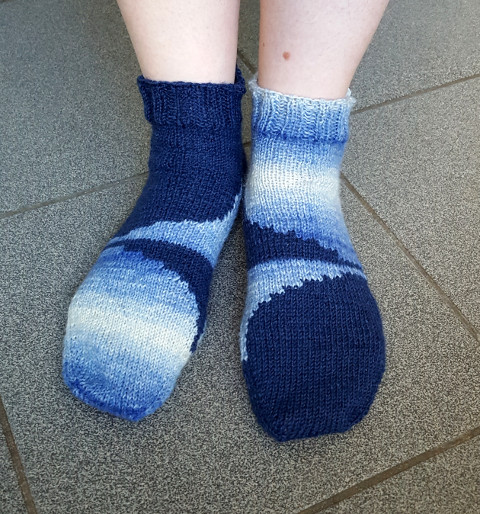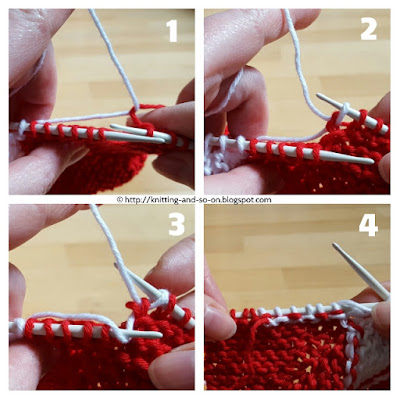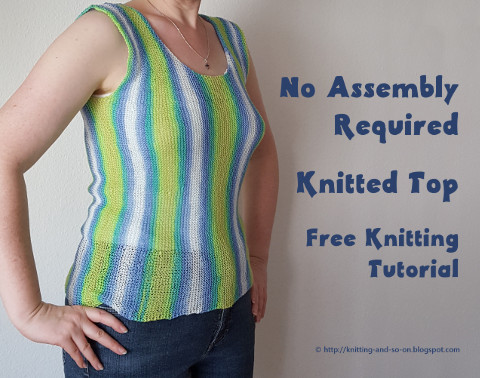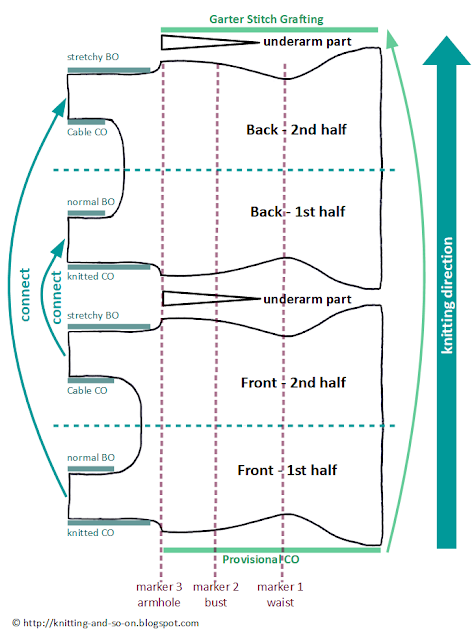The name "Hermes" (i.e. Greek god of trade, thieves, etc. who was said to wear winged sandals) was suggested by madlycreativeme on Instagram when I first posted a photo of the finished pair. Thank you!
As with my Iceberg Socks, this blogpost is rather a short sketch or recipe than a complete pattern. It is assumed that you know how to knit socks to fit your feet.

This work by Knitting and so on is licensed under a Creative Commons Attribution-NonCommercial-ShareAlike 4.0 International License.
Materials
- about 60 grams of fingering weight yarn - about 50 grams of the main color (MC, red in the pictures) and the rest of the contrast color (CC, orange in the pictures)
- 2.5 mm needles - I used 80 cm circulars and the magic loop method
- scrap yarn for the afterthought heel
- a tapestry needle to weave in ends
Techniques
- Toe up sock knitting: as explained on dummies.com or in this video by Girly Knits
- Cutting a sock template of your feet: To make the finished piece fit your feet, it is useful to measure your feet and to cut out a card template. Here's a blogpost at knitbettersocks.blogspot.com that explains the idea. If you want to knit a pair for someone else and cannot get a template, here are standard shoe size templates.
- Afterthought heel: Here's a tutorial in three videos by Knit Purl Hunter. Alternatively, you can do any kind of short row heel.
- Intarsia in the round: as shown in this YouTube video by Julia farwell-clay.
I used the method from this video. Basically you knit back and forth even though your stitches are arranged in the round - and you have to consider rounds in pairs - one RS row and one WS row. You start with your main color (MC) on the RS, then - as in normal intarsia you change (by twisting the yarns) - to contrast color (CC) and knit your CC part, After finishing this you turn your work, make a yarn-over and do the WS with CC, when you get to the MC part you change back as in normal (flat) intarsia to MC.
Now with MC you work your way on the WS not only to the start of the round, but further to the point where you ended the CC part. Here you p2tog the last MC stitch with the yarn over in CC. Then you turn - again with a yarn over - and do the RS part to the beginning of the round. That's the two round finished.
When - during the next pair of rounds - you reach the new yarn over on the RS, you have to do an ssk of the last stitch in CC with the yarn over in MC.
Instructions
Knit your toe in MC and then divide the stitches into two equal parts - 1st half = back and 2nd half = front - and place a marker between the two halves. Start to knit the intarsia pattern (consisting of intarsia blocks that are 8 stitches wide an 2 rows high) as follows:
Rounds 1 and 2:
- RS, MC: k to 4 sts before half marker, change to C
- RS, CC: k8, turn work
- WS, CC: yo, p8, chang to MC
- WS, MC: p to beginning of round, go on purling to 1 st bef yo in CC, p2tog (i.e. you purl together the last stitch in MC and the yo in CC - connecting the two), turn work
- RS: MC: yo, k to beginning of round
Round 3 (RS, MC): k to start of intarsia block and twist MC and CC yarn to avoid hole, continue to k in MC to 1 sts bef end of intarsia block, ssk (i.e. connect last sts in CC with the yo in MC), k to end
Rounds 4 and 5:
- RS, MC: k to beginning of last intarsia block, k1, change to C
- RS, CC: k8, turn work
- WS, CC: yo, p8, chang to MC
- WS, MC: p to beginning of round, go on purling to 1 st bef yo in CC, p2tog (i.e. you purl together the last stitch in MC and the yo in CC - connecting the two), turn work
- RS: MC: yo, k to beginning of round
Round 6 (RS, MC): k to start of intarsia block and twist MC and CC yarn to avoid hole, continue to k in MC to 1 sts bef end of intarsia block, ssk (i.e. connect last sts in CC with the yo in MC), k to end
Knit your toe in MC and then divide the stitches into two equal parts - 1st half = back and 2nd half = front - and place a marker between the two halves. Start to knit the intarsia pattern (consisting of intarsia blocks that are 8 stitches wide an 2 rows high) as follows:
Rounds 1 and 2:
- RS, MC: k to 4 sts before half marker, change to C
- RS, CC: k8, turn work
- WS, CC: yo, p8, chang to MC
- WS, MC: p to beginning of round, go on purling to 1 st bef yo in CC, p2tog (i.e. you purl together the last stitch in MC and the yo in CC - connecting the two), turn work
- RS: MC: yo, k to beginning of round
Round 3 (RS, MC): k to start of intarsia block and twist MC and CC yarn to avoid hole, continue to k in MC to 1 sts bef end of intarsia block, ssk (i.e. connect last sts in CC with the yo in MC), k to end
Rounds 4 and 5:
- RS, MC: k to beginning of last intarsia block, k1, change to C
- RS, CC: k8, turn work
- WS, CC: yo, p8, chang to MC
- WS, MC: p to beginning of round, go on purling to 1 st bef yo in CC, p2tog (i.e. you purl together the last stitch in MC and the yo in CC - connecting the two), turn work
- RS: MC: yo, k to beginning of round
Round 6 (RS, MC): k to start of intarsia block and twist MC and CC yarn to avoid hole, continue to k in MC to 1 sts bef end of intarsia block, ssk (i.e. connect last sts in CC with the yo in MC), k to end
Repeat rounds 4 to 6 until the sock is as long as you'd like it to be - don't forget to insert scrap yarn for an afterthought heel when the foot part of your sock is long enough.
Finish a sock with a few rounds of k1-p1-ribbing.
Insert an afterthought heel.







































